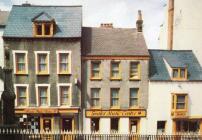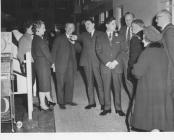Content can be downloaded for non-commercial purposes, such as for personal use or in educational resources.
For commercial purposes please contact the copyright holder directly.
Read more about the The Creative Archive Licence.
Description
Town fortifications
Caerwent has the best preserved defences of any Roman town in Britain. In the late second century, the Roman town was fortified by the construction of defensive earthworks, erected cheaply and quickly, without the help of skilled masons. Later, around AD 330, a substantial stone wall was built in front of the original earthen bank. The walls rose over 25 foot (5½ metres) and were 10 foot (3 metres) thick at their base. In front of the walls a V-shaped ditch was excavated. About 20 years later, the defences were further strengthened by the addition of a number of external towers on the south and north walls. The total circuit of the wall is over one mile in length, enclosing an area of 18 hectares (44 acres). The walls, running east-west and north-south, form an approximate rectangle. Each of the four walls originally included an entrance gateway, but the gates in the north and south walls were blocked in the late Roman period. The larger, east and west gates were left intact. The stone walls still stand 17 foot (5 metres) high in places.
Image 1:
Photography by John Ball
Looking to the south-west from the West Gate of the town.
Image 2:
Photography by John Ball
Above: Looking westwards along the south wall The hollow defensive tower projecting from the wall in the right foreground, originally possessed a wooden platform at the top from where archers would have had a clear sight along the length of the wall. The holes in the external facing of the tower mark points where wooden scaffolding was attached during construction
Image 3:
Photography by John Ball
The blocked southern entrance to the town, viewed from inside the wall. The south gate originally lay at the end of one of the town streets which ran in a north-south direction. Some time after construction, the Romans blocked the gateway with two stone walls, one at the rear of the gate (shown above) and the other in line with the front of the south wall. The space between the two walls was filled with rubble and mortar.
Church of St Stephen and St Tathan and its Roman artefacts
In the centre of Caerwent is an old Anglican church, dedicated to St Stephen and St Tathan. Parts of the church date from the 13th century; its prominent west tower is 15th century - quite modern compared with the 1,600-1,800 year-old Roman structures we have been describing! The church contains some important Roman finds (further details below).
Image 4:
Photography by John Ball
The church of St Stephen and St Tathan, viewed (above) from the east wall, and (below) from the south wall of the town.
Image 5:
Photography by John Ball
Image 6, 7:
Displayed in the church porch are these two stone blocks bearing Latin inscriptions.
Image 6:
Photography by John Ball
The inscribed base of a statue. The Latin inscription reads:
"To Tiberius Claudius Paulinus, commander of the Second Augustan Legion, once proconsul of the province of Gallia Narbonensis, now imperial governor of the province of Lugdunensis, by decree of the council of the community of the state of the Silures."
Circa AD 214, Paulinus was commandant at Isca (Caerleon), the Roman Fortress.
Image 7:
Photography by John Ball
An altar dedicated to the god Mars-Ocelus, originally found in one of the nearby Roman houses. The Latin inscription reads:
"To the god Mars Ocelus, Aelius Augustinius, optio, willingly and deservedly fulfilled his vow."
Aelius Augustinius was a soldier, probably also from the Roman Fortress at Isca.
Image 8:
Photography by John Ball
Displayed in the south aisle of the church is this fragment of Roman mosaic discovered in 1910.
Many other Roman artefacts have been discovered during archeaological excavations over the last 100 years, including those shown below. Some are on display in South Wales museums such as the National Museum of Wales (Cardiff) and the Newport Museum and Art Gallery (Newport, Monmouthshire).
Image 9:
Photograph supplied by Dilys Xavier
Four Roman artefacts recovered during the 1988 excavations.
Demise of Venta Silurum
The withdrawal of the Second Augustan Legion from Isca (Caerleon) at the end of the third century marked a turning point in the history of Venta Silurum, although an army garrison may have been maintained in the town into the fourth century. In the first half of the fourth century Venta seems to have enjoyed great prosperity but life outside the town walls was becoming increasingly insecure. Fifty years later the town was in terminal decline. By the early fifth century the Roman troops had left South Wales, and Venta degenerated into a ruinous state.
Information sources and references
BREWER, Richard J. ,1997. Caerwent Roman Town (2nd edition), CADW. Cardiff, UK: ISBN 1-85760-047-9.
SALTER, Mike, 1991. The Old Parish Churches of Gwent, Glamorgan & Gower, Folly Publications. Malvern, UK. ISBN 1-871731-08-9.
WILKINSON, Philip, 2000. What the Romans Did For Us, Boxtree. London, UK. ISBN 0-7522-1902-2.
XAVIER, Dilys, 1989. Dig Reveals Roman Town in 'British Digest Illustrated', Vol. 11 No. 3, Union Jack Publications. Florida, USA. ISSN 0196-7517.
The Roman Fortress at nearby Caerleon was featured on Images of Wales in November 2000, and is accessible here. To find out about life in modern Caerwent, visit the Caerwent Community Website
Acknowledgement
My thanks to Dilys Xavier for allowing me to use her photographs and for supplying information about the archaeological excavations in Caerwent in the 1980s and '90s.






















Do you have information to add to this item? Please leave a comment
Comments (0)
You must be logged in to leave a comment